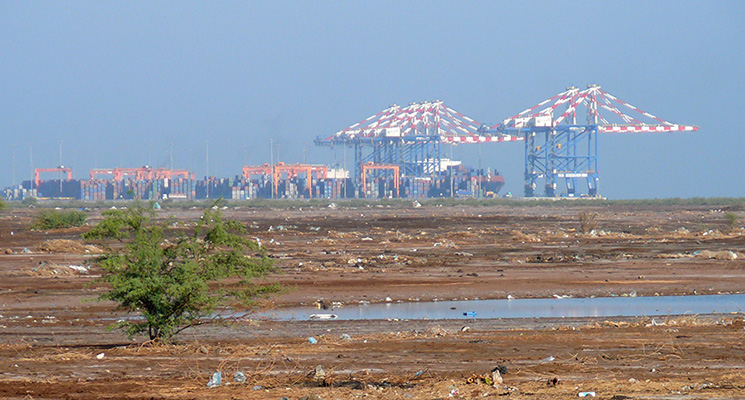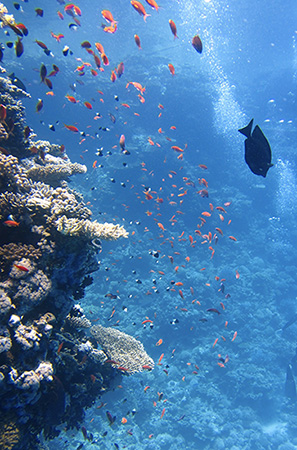 Coral reefs, mangroves forests, and seagrass beds support an incredible diversity and abundance of ocean life including fishes, invertebrates, mammals, and seabirds. These in turn support lucrative fishing and tourism industries for the countries whose waters contain them. These three types of marine habitats exist in very specific environmental conditions in shallow, warm, tropical and subtropical oceans. They are crucial to sustaining coastal marine ecosystems, yet they are susceptible to human-caused disturbances such as physical damage, pollutants, and climate change.
Coral reefs, mangroves forests, and seagrass beds support an incredible diversity and abundance of ocean life including fishes, invertebrates, mammals, and seabirds. These in turn support lucrative fishing and tourism industries for the countries whose waters contain them. These three types of marine habitats exist in very specific environmental conditions in shallow, warm, tropical and subtropical oceans. They are crucial to sustaining coastal marine ecosystems, yet they are susceptible to human-caused disturbances such as physical damage, pollutants, and climate change.
Moreover, the value of these ecosystems extends beyond fisheries to supporting the longevity of coastal communities. Coral reefs, mangroves, and seagrasses are natural buffers for waves that would otherwise erode the shoreline. They protect coasts from extreme events like storm surges and tidal waves. In addition, mangroves and seagrasses provide extra protection by binding sediment and stabilizing the shoreline. All three ecosystems serve as filters for suspended particles and pollutants, maintaining good water quality necessary for the other organisms living there.
Above: Coastal pollution surrounding a port in neighboring Djibouti. Photo credit: Jerome Michelet.
 Coral reefs
Coral reefs
Coral reefs are built by colonies of small invertebrate polyps (tentacled animals related to sea anemones and jellyfish) that secrete a limestone skeleton giving reefs their structures. It takes from decades to centuries to build a coral reef, and they are fragile and difficult to repair once damaged. Unfortunately, coral reefs face myriad threats from humans. One major threat is overfishing, which disrupts the balance of the ecosystem, leading to decreased biodiversity and environmental health. Destructive fishing practices such as bottom trawling or dynamite fishing damage or destroy the physical reef structure and degrade the integrity of habitat. Corals are also sensitive to changes in water quality. Pollution and sedimentation from activities on land affect the coral polyps and the animals living on the reef. Additionally, acidification of the ocean as a result of climate change can slow the growth of corals, making it more difficult for the reef to recover from damage.
Mangroves and Herbaceous Wetlands
Mangroves are salt-tolerant trees or shrubs that grow partially submerged in sheltered coastal areas. Likewise, herbaceous wetlands are areas of vegetation that are regularly or permanently flooded by salt or brackish water. Mangroves and wetlands act as carbon sinks, absorbing carbon from the air and sequestering it in their foliage, branches, unique root systems, and most importantly, the submerged soil where they are growing. Both ecosystems provide shoreline stability and protection against storms and rising sea level. Mangrove forests create a canopy used by birds and terrestrial animals, similar to a terrestrial forest. Their major value for the coastal ecosystem comes from those extensive root systems below the water. Mangrove roots create habitat for marine animals, especially juvenile fishes and invertebrates like crabs that can avoid large predators among the complicated root systems, or mussels that can grow on the roots themselves. Though their benefits are clear, mangroves are often cut and used as fuel, and wetland and mangrove areas are often cleared for development, or allowed to be grazed upon by livestock. They are additionally susceptible to many of the same threats as coral reefs, and therefore should be similarly protected.
Seagrasses
Seagrasses are flowering plants that grow entirely submerged in warm, shallow ocean water. They can form vast meadows that provide refuge and foraging areas for many commercially important fishes and threatened sea turtles and mammals. They also cycle nutrients that sustain life in the shallow seas and other parts of the ocean. Seagrasses depend on a delicate water chemical balance and sunlight penetration through the water, and they are therefore at risk from human activities that affect water chemistry or clarity. Mitigation measures such as sewage and water treatment and runoff prevention are especially important for preserving seagrasses.
Because these ecosystems are so sensitive, coastal development and the industries that support it, especially in large population centers, will need to proceed with these resources in mind to avoid inundating the area with pollutants. Damaging these ecosystems would undermine coastal livelihoods and potentially cause conflicts between fishing communities and developers, local, regional, and federal governments, and citizens in other coastal industries.
Key Biodiversity Areas
Key Biodiversity Areas (KBA) are areas of ecological importance. These sites are identified by the KBA partnership because they are home to threatened species, unique ecosystems, or hotspots of high biodiversity. Therefore, they are priorities for conservation and their preservation is essential to the future health of the planet. The Somali region has 25 KBAs totaling 47,449 square kilometers. Of those, six are marine sites spread along the region’s coastline. As local, national, and international attention turns to the potential impacts of climate change on the Somali region, there is increasing momentum toward protecting these unique ecosystems as valuable assets for food, livelihood, and economic security. Focusing conservation efforts on these areas, including effective fisheries management, will not only save the ecosystems, but will provide lasting security for the coastal communities that rely on these natural resources.
Go To Project Badweyn Overview and Interactive Map
Data Attribution and License Information
Coral Reefs
Data visualization by Paige Roberts. Data from: Li, J., Knapp, D.E., Fabina, N.S. et al. A global coral reef probability map generated using convolutional neural networks. Coral Reefs 39, 1805–1815 (2020). https://doi.org/10.1007/s00338-020-02005-6. Data available for download: https://allencoralatlas.org/methods/
Mangroves and Herbaceous Wetlands
Data visualization by Paige Roberts. Modified from © ESA WorldCover project 2020 / Contains modified Copernicus Sentinel data (2020) processed by ESA WorldCover consortium. For more information and data downloads see https://esa-worldcover.org/en
Seagrasses
Data simplification and visualization by Paige Roberts. The Satellite Coral Reef Mosaic is © 2022 Planet Labs and licensed CC BY-SA-NC 4.0 (https://creativecommons.org/licenses/by-nc-sa/4.0/). See the Allen Coral Atlas for the original data and methods: https://allencoralatlas.org/
Key Biodiversity Areas
The World Database of Key Biodiversity Areas (WDKBA) Spatial Dataset, September 2020. modified to show only the Somali region. Data available for download with permission: https://www.keybiodiversityareas.org/
Bibliography
Burke, Laura, Kathleen Reytar, Mark Spalding, and Allison Perry. Reefs at Risk Revisite. Washington, D.C.: World Resources Institute, 2011. http://www.wri.org/sites/default/files/pdf/reefs_at_risk_revisited.pdf
Key Biodiversity Areas.Accessed May 20, 2022. https://www.keybiodiversityareas.org/
United Nations Environment. “Seagrass.” Biodiversity A-Z. Accessed August 8, 2017. http://biodiversitya-z.org/content/seagrass
United Nations Environment. “Mangrove.” Biodiversity A-Z. Accessed August 8, 2017. http://biodiversitya-z.org/content/mangrove--2
Sanderman, Jonathan, Tomislav Hengl, Greg Fiske, Kylen Solvik, Maria Fernanda Adame, Lisa Benson, Jacob J. Bukoski et al. "A global map of mangrove forest soil carbon at 30 m spatial resolution." Environmental Research Letters 13, no. 5 (2018): 055002. https://iopscience.iop.org/article/10.1088/1748-9326/aabe1c/meta